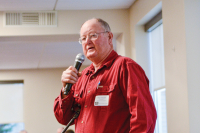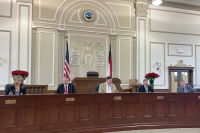Reflections on Haywood NAACP pilgrimage
By Katherine Bartel • Secretary, Haywood County NAACP
“My little brother Isaiah is, as you would call it, ‘a boy of color,’” said 11-year-old Alicia Matthews. “He is probably one of the smartest 6 year olds you’ll ever meet. One time we were playing in his room and all of a sudden he asks me a question just randomly out of the blue, ‘Alicia? Why do I have brown skin?’ At first, I didn’t know what to say to him because he is so young and he barely knew who he was. I said, ‘Because that’s who you are. So don’t try to be anyone else.’ He responded to me with a simple ‘OK’ because he is still very young and that’s just how he responds to those kinds of statements.”
The tears of these poor men: Victims of Cowee Tunnel disaster deserve recognition
In a region as rich in local lore as this, it may seem like every story’s been told to death, including that of the infamous Cowee Tunnel disaster.
North Carolina, though, is also home to the old-world tradition of telling stories through song and has an ample supply of musicians like Balsam Range frontman Buddy Melton and his buddies, Haywood native Milan Miller and Piedmont bassist Mark W. Winchester, who on their 2010 album Songs From Jackson County relate the incident about as well as anyone else ever could.
Hiking through history: Little Cataloochee offers a window to the past
One hundred years ago, the parking area and campground just past the fields in Cataloochee Valley where elk often hang out was better known as Nellie, a remote community in what is now the Great Smoky Mountains National Park.
As anybody who’s ever driven the steep and narrow access road from Jonathan Creek can imagine, it was hard to get in and hard to get out in the days when horsepower came mainly from actual horses. People didn’t have much, partly because of how difficult it was to transport outside goods up and over the ridge.
Telling Appalachia’s untold stories: Artistic effort aims to celebrate the female side of history
Just as millennia of rain and wind and heat and cold have carved the physical shape of the mountains for which Appalachia is named, so have years of immigration and emigration and peace and war carved the human culture that covers them. Through the centuries, each of millions of lives — men and women, Cherokee and white, black and Hispanic — has added its own chapter to the story.
Appalachian Women’s Museum anticipates pivotal year ahead
It’s shaping up to be a big year for the Appalachian Women’s Museum in Dillsboro. The nonprofit is preparing for its second annual Airing of the Quilts event, will get an artistically designed storytelling installation on its grounds if a grant Western Carolina University is working on goes through, and hopes to start regularly opening its doors to the public during Saturdays summer.
Maggie at 45: looking forward, looking back
Steadfast she stands in a yellow bonnet, wearing the mountain range behind her like a shawl draped upon her blouse of green, one arm clutching the yellow apron atop her red dress and the other outstretched as though waving or beckoning to someone or something unseen off in the distance.
Haywood’s ‘hidden history’: Monument to Waynesville lynching victim could prove controversial
Almost 120 years ago, local newspapers reported two separate instances of attempted rape in Haywood County.
Similarities between the two cases are many. Both victims were young girls under the age of 11, both alleged perpetrators were grown men, both knew their victims, both were apprehended and both were immediately jailed.
Jennie Churchill was anything but a prude
Mrs. Patrick Campbell, famed Victorian actress, was renowned for her sharp wit. On hearing about a sexual relationship between two contemporaries, she supposedly remarked, “My dear, I don’t care what they do, so long as they don’t do it in the street and frighten the horses.”
African-American history at Sunburst oft overlooked
In a county as old as Haywood, there exist all manner of half-remembered places and faces long gone from the physical world yet immortalized through penciled notes on the backs of dog-eared, sepia-toned photographs.
Sunburst, in southeastern Haywood County, is one of those places; the subject of intense historical research, it’s been documented better than most ghosts of Haywood past, but the story of Sunburst has always been short one chapter.
Junaluska’s story as told through historians
Editor’s note: This column first appeared in a February 2002 edition of The Smoky Mountain News.
Every reader of this column has heard of the person known as Junaluska. But what do you really know about him? What is his true significance? I decided to look into the matter. Here’s what I found. The sources I primarily depended upon for this account are cited below.





